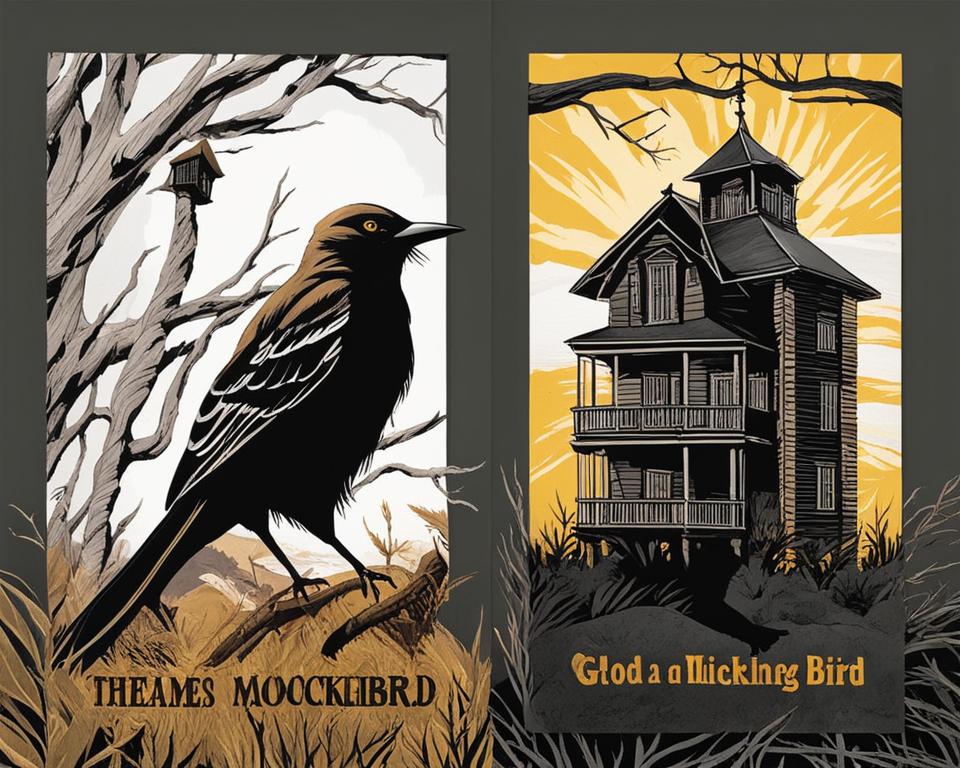In this audiobook review, we’ll take an in-depth look at “Go Set a Watchman” by Harper Lee. The novel, originally thought to be lost, was released over fifty years after Harper Lee’s classic “To Kill a Mockingbird,” and has stirred controversy and anticipation amongst the literary world. The audiobook edition is a popular way to experience Lee’s latest work, and in this review, we’ll examine its narration, characters, themes, and overall impact.
Key Takeaways
- “Go Set a Watchman” is a controversial sequel to “To Kill a Mockingbird,” and the audiobook edition offers a popular way to experience the novel.
- We’ll examine the narration, character development, themes, and impact of “Go Set a Watchman” in this review.
- This review will be helpful for anyone seeking an honest and comprehensive assessment of “Go Set a Watchman” as an audiobook.
- Overall, “Go Set a Watchman” delivers a powerful message and has lasting impact, but its reception has been mixed and should be considered by potential readers.
About the Author – Harper Lee
Harper Lee, born on April 28, 1926, was an American novelist widely known for her novel “To Kill a Mockingbird,” published in 1960. Lee grew up in Monroeville, Alabama, and developed an interest in writing at a young age. She attended the University of Alabama, where she studied law before moving to New York City to pursue a career in writing.
In 1957, Lee submitted her manuscript for “To Kill a Mockingbird” to publishers, and it was eventually accepted by J.B. Lippincott Company. The novel received critical acclaim and won the Pulitzer Prize in 1961. It remains a classic of American literature and is widely taught in schools throughout the United States.
Lee’s second novel, “Go Set a Watchman,” was published in 2015, more than 50 years after the release of “To Kill a Mockingbird.” Although “Go Set a Watchman” was marketed as a sequel, it was actually written before “To Kill a Mockingbird” and features many of the same characters at an earlier stage in their lives. The novel received mixed reviews but was still a commercial success.
Legacy and Awards
Throughout her career, Harper Lee received numerous awards and accolades for her contributions to literature. In addition to the Pulitzer Prize, she was awarded the Presidential Medal of Freedom in 2007. Lee passed away on February 19, 2016, at the age of 89, leaving behind a legacy as one of the most important American writers of the 20th century.
Synopsis of “Go Set a Watchman”
In “Go Set a Watchman,” a sequel to Harper Lee’s iconic novel “To Kill a Mockingbird,” readers follow the story of Jean Louise Finch, also known as Scout. After years of living in New York City, Scout returns to her hometown of Maycomb, Alabama, to visit her aging father, Atticus Finch. As she spends time with friends and family, she begins to confront the harsh realities of racism and segregation that still exist in the South.
The novel explores themes of family, identity, and the struggle for equality. Throughout the book, Scout grapples with her loyalty to her father and her own beliefs about morality and justice. The story is set against the backdrop of the civil rights movement, with protests and tensions rising throughout the town.
Go Set a Watchman is a poignant and thought-provoking novel that challenges readers to confront difficult truths about the world we live in.
Narration and Performance
When it comes to audiobooks, narration and performance can make or break the listening experience. In the case of “Go Set a Watchman” by Harper Lee, the audiobook narration by Reese Witherspoon adds a unique dimension to the story.
Witherspoon’s delivery style is engaging and clear, making it easy for listeners to follow the plot. Her distinctive Southern accent also adds authenticity to the story, given that the novel is set in the South. Witherspoon’s narration effectively conveys the emotions of the characters, whether it is their joy, sadness, or anger.
The audiobook performance of “Go Set a Watchman” is skillfully done, with attention to detail paid to every sentence. Witherspoon’s ability to differentiate between the various characters in the book is impressive, making it easy for listeners to distinguish between them. The overall effect of the narration is to bring the story to life in a way that is unforgettable.
In conclusion, the audiobook narration and performance of “Go Set a Watchman” is a standout feature of the audiobook version. Reese Witherspoon’s delivery style and attention to detail make this a must-listen for fans of Harper Lee’s writing and anyone who enjoys an engaging and emotive storytelling experience.
Character Development
In “Go Set a Watchman,” Harper Lee explores the growth and evolution of familiar characters from her iconic novel “To Kill a Mockingbird.” The book takes place 20 years later, and readers get to see how Scout has matured and how her relationships with others have changed.
One of the most significant character developments in “Go Set a Watchman” is that of Jean Louise, also known as Scout. She is portrayed as an independent woman who challenges her family’s beliefs, including those of her father. This new side of Scout is a stark contrast to the young girl readers met in “To Kill a Mockingbird,” and it showcases how much she has grown both intellectually and emotionally.
Another character who undergoes a transformation in “Go Set a Watchman” is Atticus Finch, a beloved character from the first novel. In “Go Set a Watchman,” Atticus’ true beliefs are challenged, and he is shown to have a more complicated character than previously depicted. This change in Atticus sparked a lot of controversy among readers and critics and was a major topic of discussion upon the release of the book.
Ultimately, the character development in “Go Set a Watchman” adds depth to the story and allows readers to see the progression of the characters they fell in love with in “To Kill a Mockingbird.” It is a fascinating exploration of how people change and grow over time and how their beliefs and relationships can be impacted by the world around them.

Themes and Messages
In “Go Set a Watchman,” Harper Lee explores several themes that are relevant to society, even today. The story takes place during the Civil Rights era, and Lee uses her characters to address issues of race, family, identity, and morality.
The theme of race is central throughout the novel, as it was in “To Kill a Mockingbird.” Lee presents a stark portrayal of the racial tensions in the South and the challenges faced by African Americans during the Jim Crow era.
Family is another theme that is explored in depth in the novel. Scout struggles with the idea of returning to her hometown and reconciling with her father, Atticus Finch. Readers witness how her family dynamics are changing and how she grapples with new family relationships.
Identity is another central theme, as Scout navigates her own identity as a young woman and comes to terms with the person she wants to be. The novel explores how identity is tied to larger issues of class, race, and culture.
Morality is an overarching theme that is explored throughout the story. Scout grapples with the idea of what is right and wrong, and readers are challenged to consider their own sense of morality and the responsibility they have towards society.
The Significance of the Themes
The themes presented in “Go Set a Watchman” are significant both in terms of the novel itself and in the social context in which it was written. Lee uses her characters to provide a commentary on the challenges and complexities of the world around them, making the story as relevant now as it was when it was first published.
The Table of Themes in “Go Set a Watchman”
| Themes | Descriptions |
|---|---|
| Race | Explores the racial tensions and challenges faced by African Americans during the Civil Rights era. |
| Family | Explores the changing dynamics of Scout’s family relationships. |
| Identity | Explores Scout’s journey and exploration of her own identity as a young woman. |
| Morality | Explores the concept of right and wrong in a complex world. |
Overall, the themes presented in “Go Set a Watchman” provide readers with a thought-provoking exploration of the world around them, as well as a unique glimpse into the historical context in which the novel is set. Through her characters and their experiences, Harper Lee presents a novel that is as relevant today as it was when it was first published.
Writing Style and Language
In “Go Set a Watchman,” Harper Lee utilizes a writing style that is both descriptive and introspective. She paints vivid pictures through her use of imagery and metaphors, allowing readers to fully immerse themselves in the story. Lee’s language is reflective of the time period in which the book is set, with southern dialect and colloquialisms adding authenticity to the characters and their experiences.
One notable aspect of Lee’s writing style is her ability to convey complex emotions and themes through subtle nuances in language. For example, the use of repetition and parallel structure in certain lines highlights the themes of identity and self-discovery.
This writing style is accessible and engaging, yet still manages to touch upon deeper issues and emotions. Overall, Lee’s style enhances the reading experience and contributes to the impact of the narrative.
Pacing and Plot Development
“Go Set a Watchman” has a deliberate and steady pace, allowing readers to fully absorb the complexity of the story. The plot builds slowly, with Harper Lee taking her time to introduce characters and conflicts with detail and nuance. The novel’s structure is primarily driven by flashbacks, as main character Jean Louise looks back on her childhood and tries to reconcile it with her present reality.
The flashbacks in “Go Set a Watchman” serve to deepen the reader’s understanding of the characters and their motivations, while also adding layers of context to the plot. This narrative technique can be challenging to follow at times, but it ultimately pays off in the end, as all the pieces of the story come together in a satisfying and thought-provoking way.
“Go Set a Watchman” is a slow-burning narrative, but it rewards patience with its carefully crafted plot and multi-dimensional characters. The book’s pacing and structure complement its themes of coming-of-age, identity, and social justice, making it a standout work of fiction.
Comparison to “To Kill a Mockingbird”
Harper Lee’s “Go Set a Watchman” is often compared to her iconic novel, “To Kill a Mockingbird.” While both books share some similarities, they are also vastly different in several aspects.
Themes and Messages
One of the most significant differences between the two books lies in their themes and messages. “To Kill a Mockingbird” deals with themes of racial inequality, social injustice, and the loss of innocence. On the other hand, “Go Set a Watchman” explores the idea of identity, self-discovery, and the complexities of family relationships.
Characterization
The characters in “Go Set a Watchman” are more nuanced and complex than those in “To Kill a Mockingbird.” Jean Louise (“Scout”) Finch, the protagonist in both books, undergoes a significant transformation that highlights her struggle to reconcile the realities of adulthood with the innocence of childhood. Atticus Finch, her father, is also portrayed differently in the two books, becoming a controversial and complicated figure in “Go Set a Watchman.”
Setting and Time Period
The setting and time period of the two books also differ significantly. “To Kill a Mockingbird” takes place in the 1930s in the fictional town of Maycomb, Alabama. “Go Set a Watchman,” on the other hand, is set in the mid-1950s, twenty years after the events of the first book, and takes place in both Maycomb and New York City.
| “To Kill a Mockingbird” | “Go Set a Watchman” | |
|---|---|---|
| Themes | Racial inequality, social injustice, loss of innocence | Identity, self-discovery, complexities of family relationships |
| Characterization | Simpler, more straightforward | Nuanced, complex |
| Setting and Time Period | Maycomb, Alabama, 1930s | Maycomb and New York City, mid-1950s |

Overall, both “To Kill a Mockingbird” and “Go Set a Watchman” are exceptional books that offer unique insights into American society and culture during different time periods. While they may share some similarities, they are also vastly different in many ways, making them both worthy of reading and analysis.
Reception and Criticism
Since its publication in 2015, “Go Set a Watchman” has received mixed reviews from both critics and readers. Some praised the book for its nuanced exploration of race and identity, while others criticized it for its depiction of Atticus Finch as a racist character.
According to The New York Times, the book sold over 1.1 million copies in its first week of release but faced significant backlash from fans of “To Kill a Mockingbird.” Many readers and critics were disappointed by the novel’s portrayal of beloved characters, including Atticus Finch, as flawed and even racist individuals.
Despite the mixed reception, “Go Set a Watchman” was a finalist for the 2016 Audie Award for Best Female Narrator, with Reese Witherspoon receiving critical acclaim for her performance. The book’s controversy and critical reception cemented its place as an important addition to Harper Lee’s literary legacy.
Impact and Legacy
The release of “Go Set a Watchman” in 2015 had a significant impact on the literary world. The novel offered readers a new perspective on the characters and themes introduced in “To Kill a Mockingbird.” While some readers were thrilled to revisit the world of Maycomb, others expressed disappointment with the book’s portrayal of beloved characters.
Despite the mixed reception, “Go Set a Watchman” remains an important piece of Harper Lee’s legacy. The novel showcases Lee’s growth and development as a writer, providing insights into her creative process and the evolution of her ideas. Furthermore, “Go Set a Watchman” serves as a poignant reminder of the ongoing struggle for racial justice in America.
The impact of “Go Set a Watchman” extends beyond the story itself. The publication of the novel sparked discussions about the importance of diversity and inclusion in publishing. It also served as a cautionary tale about the challenges of publishing posthumous works and protecting an author’s legacy.
Ultimately, “Go Set a Watchman” represents a complex and thought-provoking addition to Harper Lee’s body of work. Its legacy will continue to be debated and analyzed for years to come.
Recommended Audience
If you enjoyed reading “To Kill a Mockingbird” or are a fan of Harper Lee’s work, then “Go Set a Watchman” is definitely for you. This audiobook is well-suited for fans of classic literature, historical fiction, and coming-of-age stories. If you are interested in exploring complex family relationships and evolving societal norms, then this audiobook will be a thought-provoking listen. Additionally, if you are someone who appreciates powerful messages about racial prejudice and equality, you will find this audiobook enlightening.
The narration and performance by Reese Witherspoon make this audiobook a great choice for those who enjoy superb voice acting. Witherspoon embodies each character, bringing them to life in a unique way.
Recommended Audience
| Recommended Audience | Description |
|---|---|
| Harper Lee Fans | Those who loved reading Harper Lee’s works, including “To Kill a Mockingbird,” will appreciate this sequel. |
| Classic Literature Fans | “Go Set a Watchman” is a classic, thought-provoking novel suitable for fans of classic literature. |
| Historical Fiction Fans | This audiobook showcases the changing cultural norms of the time, making it an excellent pick for historical fiction enthusiasts. |
| Voice Acting Enthusiasts | The exceptional narration by Reese Witherspoon makes this audiobook a must-listen for those who appreciate voice acting. |
Recommended Audience: Fans of classic literature and Harper Lee’s works, historical fiction enthusiasts, voice acting fans, and those interested in exploring complex family relationships, evolving societal norms, and themes of racial prejudice and equality.
Final Verdict
After careful consideration and analysis, our final verdict on “Go Set a Watchman” is mixed. While the audiobook provides a fascinating continuation of Harper Lee’s literary legacy, it falls short in comparison to the iconic “To Kill a Mockingbird.”
The narration and performance are top-notch, with the talented Reese Witherspoon bringing the characters to life. However, the pacing and plot development are uneven, and the story lacks the same emotional depth as its predecessor.
That being said, “Go Set a Watchman” is still worth a listen for fans of Harper Lee and those interested in exploring the evolution of her characters. Recommended for those who enjoy character-driven stories and social commentary.
In summary, while “Go Set a Watchman” may not live up to the expectations set by “To Kill a Mockingbird,” it is still a valuable addition to the literary canon and offers insights into the author’s writing process and style.
FAQ
What is the audiobook “Go Set a Watchman” by Harper Lee about?
“Go Set a Watchman” is a novel written by Harper Lee and serves as a sequel to her acclaimed work “To Kill a Mockingbird.” It follows the story of an adult Scout Finch as she returns to her hometown and grapples with personal and societal conflicts.
Who is Harper Lee?
Harper Lee is a renowned American author, best known for her novels “To Kill a Mockingbird” and “Go Set a Watchman.” She was born on April 28, 1926, in Monroeville, Alabama. Lee’s debut novel, “To Kill a Mockingbird,” won the Pulitzer Prize for Fiction in 1961 and is considered a classic of American literature.
Can you provide a brief synopsis of “Go Set a Watchman” without spoilers?
Certainly! “Go Set a Watchman” follows Scout Finch, now known as Jean Louise Finch, as she returns home to Maycomb, Alabama, from New York City. The novel explores themes of racial tension, family relationships, and societal change. Throughout the story, Jean Louise confronts her personal and political beliefs, leading to a deeper understanding of herself and her community.
Who narrates the audiobook version of “Go Set a Watchman”?
The audiobook version of “Go Set a Watchman” is narrated by Reese Witherspoon. Witherspoon’s delivery style brings the characters and the story to life, adding a captivating dimension to the audiobook experience.
How do the characters in “Go Set a Watchman” develop compared to “To Kill a Mockingbird”?
In “Go Set a Watchman,” readers witness the evolution of familiar characters from “To Kill a Mockingbird.” Jean Louise Finch, Atticus Finch, and other beloved characters face new challenges and navigate complex moral dilemmas. Their growth and development showcase the impact of time and experience on their perspectives and beliefs.
What are the key themes and messages conveyed in “Go Set a Watchman”?
“Go Set a Watchman” explores themes of racial inequality, identity, and the clash between personal and societal values. Harper Lee’s novel offers a thought-provoking examination of the complexities of human nature and the challenges of navigating the changing world.
How would you describe Harper Lee’s writing style and language in “Go Set a Watchman”?
Harper Lee’s writing style in “Go Set a Watchman” is evocative and nuanced. Her use of descriptive language creates vivid imagery, immersing readers in the setting and atmosphere of the story. Lee’s storytelling is characterized by her ability to capture the essence of characters and their emotions.
How does the pacing and plot development unfold in “Go Set a Watchman”?
The pacing and plot development in “Go Set a Watchman” are deliberate and skillfully executed. Harper Lee weaves together multiple storylines, gradually building tension and suspense while exploring the central conflicts in the narrative. The plot unfolds at a pace that allows readers to fully engage with the characters and their journeys.
How does “Go Set a Watchman” compare to “To Kill a Mockingbird”?
“Go Set a Watchman” can be viewed as a companion piece to “To Kill a Mockingbird.” While both novels share some common characters and settings, they differ in terms of the time period and the perspectives of the main character, Scout Finch. Readers will find “Go Set a Watchman” to be a thought-provoking exploration of the themes introduced in “To Kill a Mockingbird.”
What has been the reception and criticism of “Go Set a Watchman”?
“Go Set a Watchman” garnered both positive and negative reviews upon its release. Some critics praised Harper Lee’s ability to tackle complex social issues, while others expressed concerns about changes in characters and narrative inconsistencies. However, it remains a significant literary work that has sparked discussions and debates among readers and scholars.
What impact has “Go Set a Watchman” had and what is its legacy?
“Go Set a Watchman” has had a notable impact on the literary world and the perception of Harper Lee’s work. While the novel raised questions and sparked conversations, it also emphasized the enduring legacy of “To Kill a Mockingbird” as a timeless masterpiece. Harper Lee’s contribution to literature and her exploration of social issues continue to resonate with readers.
Who is the recommended audience for “Go Set a Watchman”?
“Go Set a Watchman” is recommended for readers who have an interest in thought-provoking literature, character-driven storytelling, and exploring complex societal themes. Fans of Harper Lee’s “To Kill a Mockingbird” will also appreciate delving into the lives of familiar characters and seeing them in a new light.
What is the final verdict on “Go Set a Watchman”?
The final verdict on “Go Set a Watchman” is that it offers a compelling continuation of the story introduced in “To Kill a Mockingbird.” Harper Lee’s exploration of complex themes and her mastery of storytelling make it a worthwhile read for fans of her work and those who appreciate thought-provoking literature.



